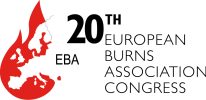Saturday 9 September
SCIENTIFIC PROGRAM
07:15
Registration desk open
COFFEE WITH THE EXPERT
Preregistration is required.
Room 150
07:30
Debride or not debride: when and how?
Jyrki Vuola, Helsinki, Finland
The debridement of a burn wound can help promote healing and prevent infection. Whether or not debridement is necessary and the specific method used depends on various factors, such as the type of wound, its depth, the extent of tissue damage, and the patient’s overall condition.
Jyrki Vuola will discuss the elements to evaluate while deciding the best treatment for a burn wound, presenting interactive clinical cases, and using a multidisciplinary approach.
Participation is free, but space is limited!
Please register now to secure your spot (with coffee and French croissant included!)

Jyrki Vuola
4.1 PARALLEL SESSION - Wounds
Moderators: Naiem Moiemen | Ariel Aballay
Room 300
08:30
O4.1.1 The study of using medical honey dressing compared to stapler for skin graft fixation in burn wounds
Sheyda Rimaz, Iran
08:40
O4.1.2 Management and outcomes of SJS/TEN in a regional burn’s unit in Northern Ireland
Lydia De Carvalho, United Kingdom
08:50
O4.1.3 The efficiency of enzymatic debridement combined with negative pressure wound therapy for deep burns treatment – a clinical study
Camelia Tamas,Romania
09:00
O4.1.4 Coverage of the hand and forearm in the electrical burn
Sung Won Jung, South Korea
09:10
O4.1.5 Nexobrid off-label use in the elderly in vall d’hebron burns unit
Alexander Lugilde Guerbek, Spain
09:20
O4.1.6 Facial burns – refined clinical pathway of conservative treatment
Albin Stritar, Slovenia
09:30
O4.1.7 Epicite (nanocellulose biotechnologically manufacture) as a first-line dressing, followed by Epifast (Cryopreserved Cultured Keratinocytes Sheet able to release grow factors) in second-degree burns.
Pablo Rodriguez-ferreyra, Mexico
4.2 PARALLEL SESSION - Organizational standards and mass casualties
Moderators: Stian Almeland | Sophia Papadopoulou
Room 200
08:30
O4.2.1 Major Burn Simulation Training: setting up a regional course
Samar Mousa, United Kingdom
08:40
O4.2.2 Assessing activity of the French Military Burn Center during the COVID-19 pandemic 2019-2022
Nicolas Donat, France
08:50
O4.2.3 Survey on the present burn care facilities and retrospective analysis of burn injury incidence in Greece: data from a multicenter study, stressing the need of initiating a National Burn Registry
Eirini Nikolaidou, Greece
09:00
O4.2.4 Thirty-six years of BABI plan: accomplishments and developments of the Belgian mass burn casualty disaster plan
Serge Jennes, Belgium
09:10
O4.2.6 Impact of decreasing burn bed capacity on non-admission rates: a 7-year retrospective study in a French military burn centre
Nicolas Donat, France
09:20
O4.2.7 Influence of electron beam irradiation on extracellular matrix of the human allogeneic skin grafts
Wojciech Łabuś, Poland
4.3 PARALLEL SESSION - Critical Care and anesthesia
Moderators: Marie Reine Losser | Juan Bosco Ruiz-Padilla
Room 150
08:30
O4.3.1 Non-invasive physical plasma of helium (generating highly reactive oxygen and nitrogen species) application as an adjuvant treatment of Epifast in superficial and deep second-degree burns
Pablo Rodriguez-ferreyra, Mexico
08:40
O4.3.2 Retrospective analysis study: enzymatic debridement (ED) in large burn patients
Jasminka Minic, Italy
08:50
O4.3.3 Utilizing Unsupervised Clustering and Latent Class Analysis to Evaluate Clinical Heterogeneity and Predict Mortality in Severely Burned Patients: A Retrospective Cohort Study
Jaechul Yoon, South Korea
09:00
O4.3.4 Use of High Flow Nasal Cannula in critical burn patient during deep sedation in enzymatic bromelain debridement (Nexobrid®): preliminary report
Antonio Tomasello, Italy
09:10
O4.3.5 Severe methemoglobinemia after using a local anesthetic in a child with a burn
Serhii Yehorov, Ukraine
09:20
O4.3.6 Bench-to-bedside assessment: high-dose vitamin C therapy In burn patients with septic shock
Amel Mokline, Tunesia
Special Interest Session
Room B/C
10:00
BREAK
Exhibition area
PLENARY SESSION
Auditorium 800
10:30
Working together: Interprofessional communication the key to success in burn care
Frank Faulhaber, Switserland | Elvira Lang, United States | David Harrington, United Kingdom
Effective interprofessional communication is essential to success in burn care. By working together, healthcare professionals can provide patients with the comprehensive care they need to recover from burn injuries and achieve the best possible outcomes.
We all want the best outcomes for our patients, and this can be achieved by sharing information, exchanging knowledge and experience, and collaborating on patient care plans.
What is the best way to communicate?
Moderators: Jill Meirte & Sophie Böttcher
The session will start with an opening panel discussion: Teresa Tredoux, Folke Sjöberg and Peter Dziewuski
Frank Faulhaber and Yvonne Kröger, Zurich, Switzerland on The role of interprofessional communication in prevention of critical incidences
Elvira Lang, Cambridge, United States on Communication and team interactions to improve quality of care
David Harrington, Providence, United Kingdom on How soft skills should be integrated in the burn care professional’s training
Discussion

David Harrington

Frank Faulhaber

Yvonne Kröger
12:00
ADJOURNEMENT / PRIZES
Auditorium 800
